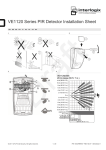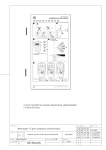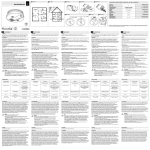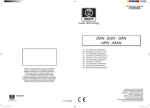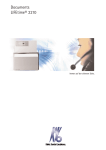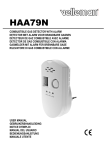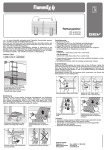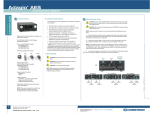Download Mode d`emploi
Transcript
FMG # 003637 1 A B 2 2 3 A B C D E A 3 Gasmelder FMG 3637 FlammEx Verhalten beim Alarm Bitte sorgfältig durchlesen und aufbewahren! Mit dem Kauf dieses Artikels haben Sie sich für ein qualitativ hochwertiges FlammEx Produkt entschieden. Bitte lesen Sie diese Bedienungsanleitung sorgfältig durch, um ein einwandfreies Funktionieren zu gewährleisten. Bewahren Sie diese Anleitung auf, um gegebenenfalls später nachlesen zu können. Das Produkt ist nur für den sachgemäßen Gebrauch (wie in der Bedienungsanleitung beschrieben) bestimmt. Änderungen, Modifikationen oder Lackierungen dürfen nicht vorgenommen werden, da sonst jeglicher Gewährleistungsanspruch entfällt. Die ordnungsgemäße Funktion ist in diesem Fall nicht gewährleistet. Was Sie über Gasmelder wissen sollten Der FlammEx Gasmelder alarmiert Sie bei Austritt von Erdgas und Flaschengas. Große Gefahr: Wenn die oben genannten Gase austreten und sich mit Sauerstoff vermischen, entsteht ein leicht entzündliches Gasgemisch. Schon der kleinste Funke kann zur Explosion führen. Der FlammEx Gasmelder alarmiert Sie weit bevor ein zündfähiges Gemisch erreicht ist. Je nach Konzentration können Sie den Geruch des Gases noch vor Alarmauslösung wahrnehmen. 1.Beim Alarm sofort versuchen, die Ursache zu ergründen und abzustellen bzw. das Gebäude räumen. 2.Türen und Fester weit öffnen. 3.Offenes Feuer vermeiden. 4.Keine elektrischen Schalter betätigen. 5.Gegebenenfalls Instandsetzung der Gasleckstelle durch einen Fachmann veranlassen. Empfehlung für optimale Sicherheit Die Installation des FlammEx Gasmelders ist in Räumen mit Anschluss der Gasanlage oder Gasgeräte zu empfehlen. Der Signalton muss deutlich hörbar sein. Montageort • Nicht in unmittelbarer Nähe der Gasgeräte montieren (z. B. direkt über dem Gasherd, Heiztherme, etc.) • Montage in Bereichen mit hoher Luftfeuchtigkeit, Dampf, Staub- oder Schmutzbelastung ist nicht geeignet. •Erdgas ist leichter als Luft, es wird also hochsteigen. Befestigung des Gasmelders ca. 30 cm unter der Decke an der Wand. •Flaschengas ist schwerer als Luft, es wird nach unten fallen. Befestigung des Gasmelders ca. 30 cm über dem Boden an der Wand. Wichtige Informationen Die Montage sollte durch eine sachkundige Person erfolgen. Ein Gasmelder ist kein Ersatz für Rauch-, Feuer- oder andere Brandmelder. Dieser Melder ist für Nutzung von privaten Einrichtungen, wie z. B.: Haus, Wohnung, Wohnwagen/mobile, Segel-/ oder Motorboot geeignet. Die Gasinstallation und eventuell vorhandene Abschaltungsvorrichtungen müssen den Landesvorschritten entsprechen (siehe z.B. EN-1775). Der FlammEx Gasmelder muss nach ca. 5 Jahren ausgetauscht werden. Befolgen Sie bei der Installation Ihres FlammEx Gasmelders genau die Instruktionen dieser Anleitung. Installation und Inbetriebnahme •Nach der Festlegung des richtigen Montageortes, befestigen Sie die Montageplatte mit den beiliegenden Dübeln und Schrauben an der Wand Abb. 1A •Setzen sie den Gasmelder auf die Montageplatte und schieben ihn nach unten bis der Melder einrastet Abb. 1B •Um die Inbetriebnahme des Gerätes zu starten, stecken Sie den Stecker in die Steckdose Abb. 2D. Beim Netzausfall keine Funktion! •Die grüne LED Abb. 2A blinkt für ca. 10 Min. (Aufwärmphase). Leuchtet die grüne LED permanent, ist das Gerät betriebsbereit. 4 Funktionsbeschreibung DE GB •Orange LED leuchtet - der Melder weist auf eine Störung hin Abb. 2B. •Blinkt die rote LED und gleichzeitig ertönt ein periodisch akustischer Alarmton, wurde Gas detektiert Abb. 2C, siehe Verhalten beim Alarm. Der Alarmausgang auf der Geräterückseite wird aktiviert Abb. 3A. •Drücken Sie den Testknopf Abb. 2E solange (bis zu 5 Sek.), bis ein lauter und pulsierender Alarmton ertönt und die rote LED blinkt Abb. 2C. •Für die Weiterleitung des Alarms verwenden Sie die Anschlussklemme auf der Rückseite Abb. 3A. Bei Alarmauslösung werden darüber 9 V ausgegeben. Fehleranalyse – Praktische Tipps Orange LED (Abb. 2B) aus Rote LED (Abb. 2C) aus Alarmton Erläuterung aus Betriebszustand Blinkt ca. 10 Min. aus aus aus Aufwärmphase Leuchtet permanent aus blinkt pulsierender Alarmton Leuchtet permanent Leuchtet permanent aus aus Alarm, siehe Verhalten beim Alarm Fehlfunktion, Gerät austauschen Leuchtet permanent blinkt blinkt pulsierender Alarmton Testalarm Leuchtet permanent aus blinkt piept kurz alle 45 Sek. Stummschaltung bei Alarm Wartung PL Grüne LED (Abb. 2A) Leuchtet permanent IT FR •Grüne LED leuchtet - der Melder ist ordnungsgemäß angeschlossen Abb. 2A. Mit dem Testknopf (auch Stummschaltungsknopf) Abb. 2E wird der Melder komplett geprüft. Ein Test sollte mindestens 1 x monatlich durchgeführt werden. Drücken Sie den Testknopf bis die rote und orangene LED blinkt und der akustische Signalton periodisch ertönt (ca. 85 dB). Eine Funktionsüberprüfung z.B. mit Feuergas ist nicht aussagekräftig. Reinigen des Melders Das Gerät sollte bei Bedarf etwa 2 x jährlich trocken abgewischt und von außen mit dem Staubsauger abgesaugt werden. Der FlammEx Gasmelder führt einen automatischen Selbsttest durch. Bei einer Fehlfunktion blinkt die orange LED Abb. 2B permanent. In diesem Fall muss der Melder ausgetauscht werden. 5 Möglicher Falschalarm Recycling-Hinweise Die Stummschaltung des FlammEx Gasmelders kann durch betätigen des Testknopfes erfolgen. Die rote LED blinkt weiter und ca. alle 45 Sek. ertönt ein kurzer Signalton. Der Gasmelder FMG 3637 FlammEx ist seinem Zweck entsprechend und zu Ihrer Sicherheit sehr empfindlich eingestellt. Der Sensor des Systems kann auch auf andere gasförmige Medien reagieren. Der Gebrauch von Aerosolen (Treibgas in Spraydosen) aber auch starker Qualm und Küchendunst kann zu Falschalarm führen. Technische Daten Netzspannung Stromverbrauch Umgebungstemperatur Relative Luftfeuchtigkeit Ansprechwelle Kalibriert gemäß Signallautstärke Alarmausgang Abmessungen Dieses Gerät darf nicht mit dem unsortierten Hausmüll entsorgt werden. Besitzer von Altgeräten sind gesetzlich dazu verpflichtet, dieses Gerät fachgerecht zu entsorgen. Informationen erhalten Sie von Ihrer Stadt- bzw. Gemeindeverwaltung. 230 V ~, 50 Hz ca. 3,4 W 0 °C ...+50 °C 5 % - 95 % ca. < 5 % der unteren Explosionsgrenze EN 50194-1 ca. 85 dB / 3 m 9 V /20 mA ca. B 80 x H 156 x L 51 mm Technische und optische Änderungen ohne Ankündigung vorbehalten. 6 Important information The device should only be installed by a competent person. Gas detectors are not a substitute for smoke, fire or other alarms. This detector is only intended for use in private properties, such as houses, flats, camper vans/mobile homes, sailing boats/motor boats. The gas installation and any safety shutdown equipment must comply with local regulations (see, for example, EN-1775). The FlammEx gas detector must be replaced after approximately 5 years. Pay close attention to the instructions provided in this user guide when installing your FlammEx gas detector. What to do in the event of an alarm 1.As soon as the alarm sounds, try to determine and eliminate the cause and/or evacuate the building. 2.Open doors and windows fully. We recommend installing the FlammEx gas detector in areas where there is a connection to the gas system or gas appliances. The alarm must be clearly audible. Mounting position • Do not install in the immediate vicinity of gas appliances (e.g. directly above a gas stove or boiler). • The device should not be installed in areas with high levels of humidity or steam, nor in very dusty or dirty areas. •Natural gas is lighter than air, which means that it will rise. Attach the gas detector to the wall, approximately 30 cm below the ceiling. •Bottled gas is heavier than air, which means that it will sink towards the floor. Attach the gas detector to the wall, approximately 30 cm above the floor. Device installation and start-up •Once you have worked out the correct place to mount the detector, fix the mounting plate to the wall using the wall plugs and screws provided Fig. 1A. •Place the gas detector on the mounting plate and push it down until it clicks into place Fig. 1B. •Connect the plug to the electric socket to launch start-up Fig. 2D. The device will not work if the power fails! •The green LED Fig. 2A will flash for approximately 10 minutes (warm-up phase). The device is ready for use once the green LED lights up continuously. •Press the test button Fig. 2E (for up to 5 seconds) until a loud, intermittent alarm can be heard and the red LED flashes Fig. 2C. •Use the terminal on the reverse of the detector Fig. 3A to relay the alarm. 9 V will be emitted via this terminal if the alarm is triggered. 7 GB FR How to maximise safety IT 3.Avoid naked flames. 4.Do not press any electrical switches. 5.Wherever possible, arrange for a technician to repair the gas leak. PL Please read these instructions carefully and keep for future reference. By purchasing this item, you have chosen a highquality FlammEx product. Please read these operating instructions carefully to ensure correct operation and keep them in a safe place so that you can refer back to them if necessary. Use this product only as intended (as described in the operating instructions). Any changes or modifications made to the product, including painting the device, will result in loss of warranty. We cannot guarantee that the device will function correctly under these circumstances. What you need to know about gas detectors The FlammEx gas detector raises the alarm if there is a leak of natural or bottled gas. Warning! If these gases leak out and mix with oxygen, a highly flammable gaseous mixture will develop. Even the smallest of sparks can cause an explosion. The FlammEx gas detector raises the alarm long before a flammable mixture is formed. Depending on the concentration, you may be able to smell the gas before the alarm is triggered. DE FMG 3637 FlammEx gas detector Description of functions •If the red LED flashes and there is an intermittent audible alarm, this means that the device has detected gas Fig. 2C, please refer to the section What to do in the event of an alarm. The alarm output on the back of the device will be activated Fig. 3A. •Green LED lights up - the detector has been connected correctly Fig. 2A. •Orange LED lights up - the detector is indicating that there is a fault Fig. 2B. Troubleshooting - practical advice Green LED (Fig. 2A) Constantly lit Orange LED (Fig. 2B) off Red LED (Fig. 2C) off Alarm Description off Normal operation Flashes, for approx. 10 mins. off off off Warm-up phase Constantly lit off flashing intermittent alarm Constantly lit Constantly lit off off Alarm, please refer to What to do in the event of an alarm Fault, change device Constantly lit flashing flashing intermittent alarm Test alarm Constantly lit off flashing short beep every 45 sec. Alarm has been silenced Maintenance Cleaning the detector The detector can be fully tested using the test button (also the mute button) Fig. 2E. Perform a test at least once a month. Press and hold down the test button until the red and orange LEDs flash and the audible alarm sounds intermittently (approx. 85 dB). It is not sufficient to simply test operability by using a gas fire device, such as a gas lighter or a gas stove. When necessary (usually about twice a year), wipe the device with a clean, dry cloth and clean the outside with a vacuum cleaner. The FlammEx gas detector automatically performs a self-test. If there is a fault, the orange LED Fig. 2B will flash continuously. This indicates that the detector needs to be replaced. 8 Technical data Mains voltage Electricity consumption Ambient temperature Relative humidity Response threshold Calibrated acc. to Signal volume Alarm output Dimensions DE FR This device may not be disposed of with unsorted household waste. Owners of old devices are required by law to dispose of this device correctly. Contact your town council for further information. GB Recycling instructions 230 V ~, 50 Hz approx. 3.4 W 0 °C ...+50 °C 5 % - 95 % approx. < 5% of the lower explosion limit EN 50194-1 approx. 85 dB/3 m 9 V /20 mA approx. W 80 x H 156 x D 51 mm Technical and design features may be subject to change without notice. 9 IT You can silence the FlammEx gas detector by pressing the test button. The red LED will continue to flash and a short alarm will sound approximately every 45 seconds. To fulfil its purpose and to ensure your safety, the FMG 3637 FlammEx gas detector is designed to be highly sensitive. The system's sensor may also react to other gaseous media. The use of aerosols (propellants in spray cans), as well as thick smoke and cooking vapours, may trigger a false alarm. PL Potential for false alarms Détecteur de gaz FMG 3637 FlammEx Veuillez lire minutieusement et conserver ces instructions. En achetant cet article, vous avez choisi un produit FlammEx de qualité supérieure. Pour l'utiliser dans les meilleures conditions, nous vous recommandons de lire attentivement ce mode d'emploi. Conservez ce document en vue d'une éventuelle consultation future. Ce produit ne doit être utilisé que dans les conditions prévues par le présent mode d'emploi. Toute modification (physique, esthétique, etc.) du produit entraîne l'annulation de la garantie. Dans ce cas, le bon fonctionnement de l’appareil n’est pas assuré. Ce que vous devez savoir sur les détecteurs de gaz Le détecteur de gaz FlammEx émet une alarme en présence de gaz naturel et en bouteille. Danger : la fuite de l'un des gaz ci-dessus dans l'oxygène peut conduire à la formation d'un mélange gazeux hautement inflammable. La moindre étincelle peut alors provoquer une explosion. Le détecteur de gaz FlammEx vous alerte bien avant que le mélange ne soit inflammable. Selon la concentration du gaz, son odeur peut être perceptible avant le déclenchement de l'alarme. Informations importantes Le montage doit être réalisé par une personne compétente. Un détecteur de gaz ne se substitue en aucune façon à un détecteur de fumée ou d’incendie ! Ce détecteur est adapté à une utilisation dans les installations privées, p. ex. les maisons, appartements, caravanes, camping-cars et bateaux à voile ou à moteur. Votre installation de gaz et éventuellement les dispositifs de désactivation existants doivent être conformes aux règles en vigueur dans le pays (voir p. ex. EN-1775). Nous vous recommandons de remplacer votre détecteur de gaz FlammEx 5 ans après sa date d’achat. Pour le montage de votre détecteur de gaz FlammEx, veuillez suivre rigoureusement les instructions de cette notice. 10 Que faire en cas de déclenchement de l'alarme 1.Si l'alarme se déclenche, essayez immédiatement d'en rechercher et d'en résoudre la cause ou d'évacuer le bâtiment. 2.Ouvrez en grand les portes et les fenêtres. 3.Évitez les flammes nues. 4.N'actionnez aucun interrupteur électrique. 5.Si besoin, faites réparer la fuite par un spécialiste. Recommandation pour une sécurité optimale L'installation du détecteur de gaz FlammEx est recommandée dans les pièces possédant un raccordement avec une installation au gaz ou des appareils à gaz. Le signal sonore doit être clairement audible. Lieu de montage et positionnement • N'installez pas cet appareil juste à côté d'un appareil à gaz (par ex. juste au-dessus d'une gazinière ou d'une chaudière). • L'installation du détecteur n'est pas adaptée dans les pièces très humides, sujettes à la vapeur, très poussiéreuses ou très sales. •Le gaz naturel est plus léger que l'air et se dirige donc vers le haut de la pièce. Installez le détecteur de gaz sur un mur, env. 30 cm au-dessous du plafond. •Le gaz en bouteille est plus lourd que l'air et se dirige donc vers le sol. Installez le détecteur de gaz sur un mur, env. 30 cm au-dessus du sol. Installation et mise en service •Une fois l'emplacement de montage défini, fixez la plaquette de montage au mur à l'aide des chevilles et des vis fournies fig. 1A. •Posez le détecteur de gaz sur la plaquette de montage et faites-le coulisser vers le bas jusqu'à ce qu'il s'emboîte fig. 1B. •Pour commencer la mise en service de l'appareil, branchez la prise fig. 2D. En cas de panne de réseau, le dispositif ne fonctionne pas. •La LED verte (fig. 2A) clignote pendant environ 10 min (phase d'initialisation). Une fois qu'elle LED verte (fig. 2A) allumée LED orange (fig. 2B) éteinte LED rouge (fig. 2C) éteinte Signal sonore Explication éteint fonctionnement normal clignote 10 min env. éteinte éteinte éteint phase d'initialisation allumée éteinte clignote répétitif alarme, voir Que faire en cas de déclenchement de l'alarme allumée allumée éteinte éteint dysfonctionnement : remplacer l'appareil. allumée clignote clignote répétitif alarme de test allumée éteinte clignote bip court toutes les 45 s alarme en fonction silence Maintenance Le bouton de test (aussi bouton de fonction silence) fig. 2E permet de contrôler entièrement le fonctionnement du détecteur. Il est recommandé de procéder au moins à un test par mois. Maintenez le bouton de test enfoncé jusqu'à ce que la LED clignote en rouge et orange et que le signal sonore retentisse de manière discontinue (env. 85 dB). Une vérification du fonctionnement p. ex. avec du gaz de combustion est inutile. 11 DE GB FR Dysfonctionnements – Conseils pratiques IT •LED verte allumée - le détecteur est correctement raccordé fig. 2A. •LED orange allumée - le détecteur signale un dysfonctionnement fig. 2B. •Si une LED rouge clignote en association avec un signal sonore discontinu, du gaz a été détecté fig. 2C, voir Que faire en cas de déclenchement de l'alarme. La sortie alarme à l'arrière de l'appareil est activée fig. 3A. PL Fonctionnement cesse de clignoter et reste allumée en permanence, l'appareil est prêt à l'emploi. •Maintenez le bouton de test enfoncé fig. 2E (pendant 5 s environ) jusqu'à ce qu'un signal sonore puissant et répétitif retentisse et que la LED rouge clignote fig. 2C. •Pour mettre en place une retransmission de l'alarme, utilisez le bornier situé à l'arrière fig. 3A. En cas de déclenchement de l'alarme, ce bornier émet une tension de 9 V. Nettoyage du détecteur Remarques concernant le recyclage Lorsque cela s’avère nécessaire, essuyez l’appareil avec un chiffon sec et aspirez les poussières (deux fois par an environ). Le détecteur de gaz FlammEx procède à un test automatique. En cas de dysfonctionnement, la LED orange fig. 2B reste allumée. Dans ce cas, remplacez le détecteur. Cet appareil ne doit en aucun cas être jeté avec les ordures ménagères. Les propriétaires d'équipements électriques ou électroniques usagés ont en effet l'obligation légale de les déposer dans un centre de collecte sélective. Informezvous auprès de votre municipalité sur les possibilités de recyclage. Possibilité de fausse alerte La fonction silence du détecteur de gaz FlammEx peut être enclenchée au moyen du bouton de test. La LED rouge clignote durablement et un bref signal sonore retentit toutes les 45 s environ. Conformément à son objectif et pour votre sécurité, le détecteur de gaz FMG 3637 FlammEx est réglé sur un niveau de sensibilité très élevé. Le capteur du système peut réagir à d'autres fluides gazeux. L'utilisation d'aérosols (gaz propulseur des sprays), mais aussi une fumée et une vapeur de cuisine abondantes peuvent entraîner une fausse alerte. Caractéristiques techniques Alimentation Consommation électrique Plage de températures ambiantes de fonctionnement Humidité relative Seuil de transmission Norme d'étalonnage Volume du signal Sortie alarme Dimensions 230 V ~, 50 Hz env. 3,4 W 0 °C ...+50 °C 5 % - 95 % env. < 5 % de la limite inférieure d'explosivité EN 50194-1 env. 85 dB / 3 m 9 V /20 mA env. l 80 x h 156 x L 51 mm Des modifications techniques et esthétiques peuvent être apportées sans notification préalable. 12 3.Evitare fiamme libere. 4.Non azionare interruttori di apparecchi elettrici. 5.Eventualmente disporre il ripristino della perdita di gas da parte di personale specializzato. Informazioni importanti Installazione e messa in funzione Il montaggio deve essere eseguito da personale specializzato. Un rilevatore di gas non sostituisce un rilevatore fumo, fiamma o altri rilevatori di incendio. Il presente rilevatore è concepito per l'utilizzo in strutture private, come case, appartamenti, camper/roulotte, barche a vela o a motore. L'impianto del gas e ogni eventuale dispositivo di sicurezza devono essere conformi alle norme applicabili (cfr. EN-1775). Si consiglia di sostituire il rilevatore di gas FlammEx dopo circa 5 anni dall'acquisto. Durante l'installazione del rilevatore di gas FlammEx, attenersi scrupolosamente alle istruzioni del presente manuale. Come comportarsi in caso di allarme 1.Se scatta l'allarme, tentare immediatamente di individuarne ed eliminarne la causa o lasciare l'edificio. 2.Aprire completamente porte e finestre. Per un livello di sicurezza ottimale Si consiglia di installare il rilevatore di gas FlammEx nelle stanze in cui si trovano l'allaccio del gas o apparecchiature a gas. Il volume del segnale deve essere chiaramente percepibile. FR Leggere attentamente e conservare queste istruzioni per l'uso. Con l'acquisto di questo articolo si è scelto un prodotto FlammEx di qualità superiore. Per garantire un corretto funzionamento, leggere le istruzioni per l'uso e conservarle per un'eventuale consultazione successiva. Il prodotto è destinato solo all'utilizzo previsto (come descritto nelle istruzioni per l'uso). Non è consentito eseguire variazioni, modifiche o verniciature, pena l'annullamento della garanzia. In questo caso il funzionamento corretto non è garantito. Cose da sapere sui rilevatori di gas Il rilevatore di gas FlammEx vi avverte in caso di perdite di gas naturale e in bombola. Pericolo elevato: se questi gas fuoriescono e si mischiano all'ossigeno si crea una miscela facilmente infiammabile. La minima scintilla potrebbe provocare un'esplosione. Il rilevatore di gas FlammEx vi avverte prima che si crei una miscela infiammabile. La possibilità di percepire l'odore del gas anche prima che si attivi l'allarme dipende dai livelli di concentrazione. GB DE Rilevatore di gas FMG 3637 FlammEx •Una volta individuato il punto di installazione più adatto, fissare la piastra di montaggio alla parete servendosi dei tasselli e delle viti Fig. 1A. •Posizionare il rilevatore di gas sulla piastra di montaggio e farlo scorrere verso il basso fino a incastrarlo nella sede Fig. 1B. •Per mettere in funzione l'apparecchio è necessario collegare la presa della corrente Fig. 2D. Senza alimentazione non funziona. •Il LED verde Fig. 2A lampeggia per circa 10 min. (fase di riscaldamento). Quando il LED verde è fisso, l'apparecchio è pronto. •Premere il pulsante TEST Fig. 2E (circa 5 secondi) fino a quando viene emesso un forte tono di allarme pulsato e il LED rosso lampeggia Fig. 2C. •Per la trasmissione dell'allarme servirsi del connettore sul retro Fig. 3A. La potenza di questo connettore con allarme attivo è di 9 V. 13 PL • Non montare nelle immediate vicinanze di apparecchiature a gas (es.: direttamente sopra i fornelli, caldaie, ecc.). • Non indicato per il montaggio in zone con presenza di umidità, vapore, polvere o sporco. •Il gas naturale è più leggero dell'aria e pertanto tende a salire. Il rilevatore di gas va montato sulla parete a circa 30 cm dal soffitto. •Il gas in bombola è più pesante dell'aria e pertanto tende a scendere. Il rilevatore di gas va montato sulla parete a circa 30 cm dal pavimento. IT Luogo di installazione Descrizione del funzionamento •LED rosso lampeggiante e segnale d'allarme acustico attivo a intervalli periodici: è stata rilevata la presenza di gas Fig. 2C. Consultare la sezione Come comportarsi in caso di allarme. Si attiva l'uscita dell'allarme sul retro dell'apparecchio Fig. 3A. •LED verde acceso: il rilevatore è correttamente collegato Fig. 2A. •LED arancione acceso: il rilevatore è guasto Fig. 2B. Analisi dei problemi – Consigli pratici LED verde (Fig. 2A) Acceso fisso LED arancione (Fig. 2B) off LED rosso (Fig. 2C) off Tono di allarme Spiegazione off Operativo Lampeggia per circa 10 min. off off off Fase di riscaldamento Acceso fisso off lampeggiante Tono pulsato Acceso fisso Acceso fisso off off Acceso fisso lampeggiante lampeggiante Tono pulsato Allarme, vedere Come comportarsi in caso di allarme Malfunzionamento, sostituzione dell'apparecchio necessaria Allarme di prova Acceso fisso off lampeggiante Emette un breve bip ogni 45 sec. Manutenzione Pulizia del rilevatore Il pulsante di prova (o muto) Fig. 2E permette di eseguire un test completo del rilevatore. Si consiglia di eseguire almeno una prova al mese. Premere il pulsante TEST fino a quando il LED rosso e quello arancione lampeggiano e si attiva il segnale acustico a intervalli periodici (circa 85 dB). Test eseguiti azionando apparecchiature a gas non sono affidabili. Attivazione della funzione "muto" in caso di allarme All’occorrenza, pulire il dispositivo 2 volte l’anno con un panno asciutto ed esternamente con l'aspirapolvere. Il rilevatore di gas FlammEx esegue un test automatico. In caso di guasto, il LED arancione lampeggia ininterrottamente Fig. 2B. In questo caso il rilevatore deve essere sostituito. 14 Dati tecnici Tensione di rete Consumo di corrente Temperatura ambiente Umidità relativa dell’aria Soglia di attivazione Calibrato in base a Volume del segnale Uscita allarme Dimensioni DE FR Questo dispositivo non deve essere smaltito come rifiuto indifferenziato. I possessori di vecchi dispositivi non funzionanti sono tenuti per legge allo smaltimento nel rispetto delle normative in vigore. Per ulteriori informazioni rivolgersi all'amministrazione comunale. GB Indicazioni per il riciclaggio IT La funzione "muto" del rilevatore di gas FlammEx può essere attivata premendo il pulsante TEST. Il LED rosso continua a lampeggiare e ogni 45 secondi circa viene emesso un breve segnale acustico. Il rilevatore di gas FMG 3637 FlammEx è impostato su parametri particolarmente sensibili proprio per la sua destinazione d'uso e per la sicurezza degli utenti. Il sensore del sistema può quindi reagire anche in presenza di altre sostanze in forma gassosa. Falsi allarmi possono scattare in caso di utilizzo di aerosol (gas in bombolette spray), ma anche in presenza di nebbiolina molto fitta e fumi da cucina. 230 V ~, 50 Hz ca. 3,4 W 0 °C ...+50 °C 5 % - 95 % ca. < 5 % della soglia di esplosione inferiore EN 50194-1 ca. 85 dB/3 m 9 V /20 mA ca. B 80 x H 156 x P 51 mm L’azienda si riserva il diritto di apportare modifiche tecniche ed estetiche senza preavviso. 15 PL Falso allarme Czujka gazu FMG 3637 FlammEx Prosimy starannie przeczytać i zachować niniejszą instrukcję! Kupno niniejszego artykułu oznacza wybór wysokiej jakości wyrobu marki FlammEx. Aby zapewnić prawidłowe działanie wyrobu, prosimy o uważne zapoznanie się z niniejszą instrukcją obsługi. Instrukcję tę należy przechowywać do ewentualnego późniejszego użytku. Wyrób może być stosowany wyłącznie w sposób zgodny z przeznaczeniem (opisany w instrukcji obsługi). Zabrania się dokonywania zmian, przeróbek bądź zamalowywania urządzenia, gdyż w przeciwnym razie wszelkie roszczenia z tytułu gwarancji będą nieważne. W takim wypadku nie jest zapewnione prawidłowe działanie wyrobu. Co należy wiedzieć o czujkach gazu Czujka gazu FlammEx alarmuje użytkownika w przypadku wycieku gazu ziemnego lub typu propanbutan. Poważne niebezpieczeństwo: w przypadku wycieku powyższych gazów i zmieszania ich z powietrzem powstaje łatwo zapalna mieszanina gazów. Nawet najmniejsza iskra może prowadzić do wybuchu. Czujka gazu FlammEx alarmuje użytkownika przed powstaniem łatwo zapalnej mieszaniny. W zależności od stężenia, zapach gazu może być wyczuwalny jeszcze przed zadziałaniem alarmu. niniejszej instrukcji. Postępowanie w przypadku alarmu 1.W przypadku alarmu spróbuj niezwłocznie spróbować zlokalizować i wyeliminować przyczynę, ewentualnie ewakuuj siebie i inne osoby z budynku. 2.Otwórz na oścież drzwi i okna. 3.Unikaj otwartego ognia. 4.Nie korzystaj z żadnych przełączników elektrycznych. 5.W razie potrzeby zleć naprawę miejsca wycieku gazu specjaliście. Zalecenie dla optymalnego bezpieczeństwa Zaleca się zainstalowanie czujki gazu FlammEx w pomieszczeniach, w których znajdują się przyłącza lub urządzenia gazowe. Dźwięk sygnału musi być wyraźnie słyszalny. Miejsce montażu Ważne informacje Montaż powinien zostać wykonany przez osobę posiadającą odpowiednie kwalifikacje. Czujka gazu nie jest zamiennikiem czujki dymu, pożaru ani innych czujek przeciwpożarowych. Czujka ta jest przewidziana wyłącznie do stosowania w obiektach prywatnych, np. domu, mieszkaniu, samochodzie lub przyczepie kempingowej, na łodzi żaglowej lub motorowej. Instalacja gazowa wraz z dostępnymi urządzeniami odcinającymi dopływ gazu musi odpowiadać krajowym przepisom (zob. np. EN-1775). Czujkę gazu FlammEx należy wymienić po upływie ok. 5 lat. Instalując czujkę gazu FlammEx, należy postępować ściśle według wskazówek zawartych w 16 • Nie montuj czujki w bezpośrednim sąsiedztwie urządzeń gazowych (np. tuż nad kuchenką, podgrzewaczem itp.) • Czujki nie należy montować w miejscach o dużej wilgotności powietrza bądź takich, w których występują duże ilości pary, pyłu lub zanieczyszczeń. •Gaz ziemny jest lżejszy od powietrza, dlatego unosi się ku górze. Czujkę gazu należy zamontować na ścianie w odległości ok. 30 cm od sufitu. •Gaz typu propan-butan jest cięższy od powietrza, dlatego przemieszcza się w dół. Czujkę gazu należy zamontować na ścianie w odległości ok. 30 cm nad podłogą. Instalacja i uruchomienie •Po wyznaczeniu odpowiedniego miejsca montażu (rys. 1 – 4) przymocuj płytę montażową do ściany za pomocą dostarczonych w zestawie kołków i wkrętów, zob. rys. 1A. •Umieść czujkę na płycie montażowej i przesuń w kierunku dół aż do zatrzaśnięcia, zob. rys. 1B. •Aby rozpocząć uruchamianie urządzenia, włóż wtyczkę do gniazdka, zob. rys. 2D. Czujka nie działa przy braku napięcia sieciowego! •Zielona dioda LED, rys. 2A, błyska przez ok. 10 min DE GB •Zielona dioda LED świeci się — czujka jest prawidłowo podłączona, zob. rys. 2A. •Pomarańczowa dioda LED świeci się — czujka sygnalizuje usterkę, zob. rys. 2B. •Gdy czerwona dioda LED błyska i równocześnie słychać okresowy dźwięk alarmu, nastąpiło wykrycie gazu, zob. rys. 2C oraz punkt Postępowanie w przypadku alarmu. Następuje uaktywnienie wyjścia alarmowego na tylnej ściance urządzenia, zob. rys. 3A. FR Opis funkcji (faza nagrzewania). Gdy zielona dioda LED świeci ciągle, urządzenie jest gotowe do pracy. •Naciskaj i przytrzymaj przycisk testu, rys. 2E (maks. 5 s), aż będzie słyszalny głośny, pulsujący dźwięk alarmu , a czerwona dioda LED zacznie błyskać, zob. rys. 2C. •Do przekazywania alarmów dalej użyj umieszczonego z tyłu zacisku łączeniowego, zob. rys. 3A. W przypadku zadziałania alarmu pojawi się na nim napięcie 9 V. Zielona dioda LED (rys. 2A) Świeci ciągle Pomarańczowa dioda LED (rys. 2B) wyłączona Czerwona dioda LED (rys. 2C) wyłączona Dźwięk alarmu Objaśnienie IT wyłączona Stan pracy PL Analiza błędów — wskazówki praktyczne Błyska co ok. 10 minut wyłączona wyłączona wyłączona Faza rozgrzewania Świeci ciągle wyłączona błyska pulsujący dźwięk alarmowy Świeci ciągle Świeci ciągle wyłączona wyłączona Alarm, zob. Postępowanie w przypadku alarmu Awaria, wymień urządzenie Świeci ciągle błyska błyska pulsujący dźwięk alarmowy Alarm testowy Świeci ciągle wyłączona błyska krótki pisk co ok. 45 s Wyciszenie alarmu 17 Konserwacja Możliwy fałszywy alarm Przycisk testu (jak również przycisk wyciszenia, zob. rys. 2E) umożliwia pełne sprawdzenie czujki. Test powinien być przeprowadzany co najmniej raz w miesiącu. Naciśnij przycisk testu aż zacznie błyskać czerwona i pomarańczowa dioda LED i zacznie być słyszalny okresowy sygnał dźwiękowy (o głośności ok. 85 dB). Kontrola działania np. za pomocą gazu z zapalniczki nie jest miarodajna. Istnieje możliwość wyciszenia czujki gazu FlammEx przez naciśnięcie przycisku testu. Czerwona dioda LED błyska nadal i co 45 s słychać krótki sygnał akustyczny. Czujka gazu FMG 3637 FlammEx jest nastawiona na bardzo wysoką czułość, odpowiednio do swojego przeznaczenia i z myślą o bezpieczeństwie użytkownika. Czujnik systemu może również reagować na inne substancje lotne. Korzystanie z aerozoli (propelentów w pojemnikach z rozpylanymi substancjami), ale również dym i opary z kuchni mogą powodować powstawanie fałszywych alarmów. Czyszczenie czujki Urządzenie w razie potrzeby należy przecierać mniej więcej dwa razy w roku na sucho i czyścić z kurzu za pomocą odkurzacza. Czujka gazu FlammEx w sposób ciągły przeprowadza test automatyczny. W przypadku nieprawidłowego działania pomarańczowa dioda LED (rys. 2B) błyska przez cały czas. W takim wypadku czujkę należy wymienić. Dane techniczne Napięcie sieciowe Pobór prądu temperatura otoczenia Wilgotność względna Próg zadziałania Kalibracja wg Głośność sygnału Wyjście alarmowe Wymiary Uwagi dotyczące recyklingu Niniejszego urządzenia nie wolno usuwać razem z niesortowanymi odpadami domowymi. Posiadacze zużytego sprzętu są ustawowo zobowiązani do zapewnienia prawidłowej utylizacji urządzeń. Odpowiednie informacje można uzyskać u odpowiednich władz miejskich lub gminnych. 230 V ~, 50 Hz ok. 3,4 W 0 °C ...+50 °C 5 % - 95 % ok. 5 % dolnej granicy zagrożenia wybuchem EN 50194-1 ok. 85 dB/3 m 9 V /20 mA ok. 80 x 156 x 51 mm (szer. x wys. x dł.) Zastrzega się możliwość wprowadzania zmian technicznych i wizualnych bez wcześniejszego powiadomienia. 18 19 Max. 14 Ct./Min aus dem deutschen Festnetz. Mobil max. 42 Ct./Min. International calls may vary. 15UW01 MA00425401 GEV GmbH Heidehofweg 16 25499 Tangstedt Germany www.gev.de [email protected] Hotline: +49 (0)180/59 58 555





















